Geometry, features, and orientation in vertebrate
animals: A pictorial review
Ken Cheng and Nora S. Newcombe
Macquarie University & Temple University
Humans
Hermer and Spelke (1994, 1996) tested children of 18-24 months in a reference memory paradigm, albeit one with only 4 trials. In all the experiments, the hidden toy remained in one corner throughout training. The children were disoriented between trials, so that they had to use cues within the arena to orient.
They found that the children used geometric properties readily but did not use featural properties. In later work, this lab found that featural cues began to be used at 6 years of age and were virtually always used by adults.
Figure F-1 shows a schematic drawing of their 4 by 6 foot rectangular room. Figure F-2 shows a photo of a room this size used by the Newcombe lab. Figure F-3 shows representative results from one of the Hermer-Spelke experiments with children, followed by a representative result with adults in Figure F-4.
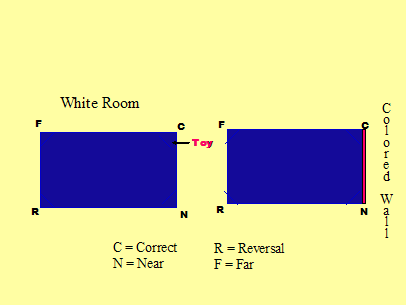 |
| Figure F-1:
Hermer & Spelke (1994, 1996) experimental
conditions
|
Hermer and Spelke (1994, 1996) tested children of 18-24 months in a reference memory paradigm, albeit one with only 4 trials. In all the experiments, the hidden toy remained in one corner throughout training. The children were disoriented between trials, so that they had to use cues within the arena to orient.
They found that the children used geometric properties readily but did not use featural properties. In later work, this lab found that featural cues began to be used at 6 years of age and were virtually always used by adults.
This figure shows a schematic drawing of their 4 by 6 foot rectangular room. The next slide shows a photo of a room this size used by the Newcombe lab. The figure after that shows representative results from one of the Hermer-Spelke experiments with children, followed by a representative result with adults.
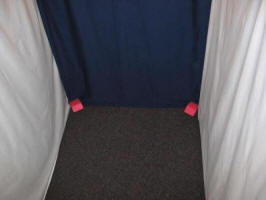 |
| Figure F-2:
Overhead View of a Small Rectangular Room with
Identical Boxes Used to Hide Small Toys
|
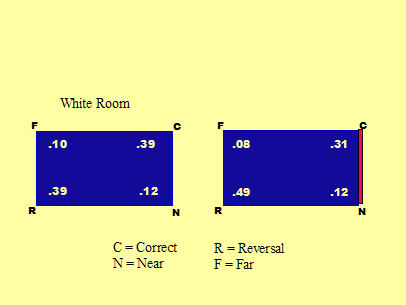 |
| Figure F-3:
Hermer & Spelke: Search Rates for Toddlers
|
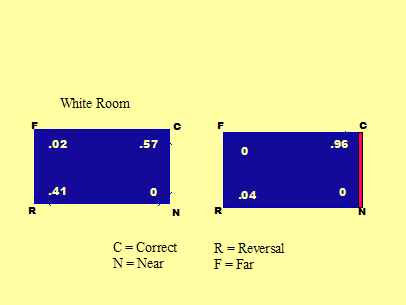 |
| Figure F-4:
Hermer & Spelke: Search Rates for Adults
|
This pattern of data led the Spelke group to propose the “Language-as-Bridge” hypothesis. As put by Hermer-Vazquez, Spelke & Katsnelson (1999, p. 34):
"[A]dults may have a further system of representation that is uniquely human and that emerges over the course of development. This system may connect to many other systems of representation, regardless of their domain-specific content. Its operation may be governed by rules and principles allowing the arbitrary combination of information from distinct, domain-specific sources… The language faculty appears to have all the right properties to serve as this uniquely human combinatorial system of representation."
More recent work has followed up both on young children’s sensitivity and on whether or not they use features as well as geometry.
Taking geometric sensitivity first, Huttenlocher and Vasilyeva (2003) found that children could use geometry to find a hidden object in enclosures of different shapes, triangles as well as rectangles, both when inside and when outside the space. However, they did better when inside the space.
Children rarely surveyed the various locations before going to the corner where they believed the object was hidden, suggesting that they represent the entire space so that, no matter where they face after disorientation, they know their relation to the hiding corner.
Using geometric information is easier when an organism is inside a space than outside a space (Huttenlocher & Vasilyeva, 2003). As shown in Figure F-5, one likely reason is that the distinctiveness of the space is greater when inside.
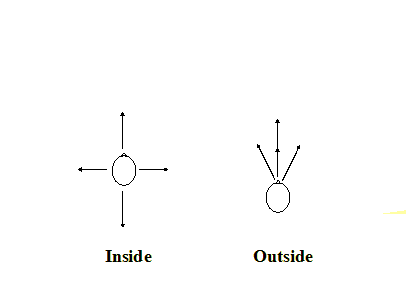 |
| Figure F-5: Perspectives inside and outside of a space |
Using geometric information is easier when an organism is inside a space than outside a space (Huttenlocher & Vasilyeva, 2003). As shown in Figure F-5, one likely reason is that the distinctiveness of the space is greater when inside.
Learmonth, Newcombe, & Huttenlocher (2001) found that toddlers CAN use features to reorient, as shown by the data in Figure F-6. Searches were much more likely in the correct corner than in the rotational equivalent.
 |
| Figure F-6: Learmonth, Newcombe, & Huttenlocher (2001) experiment |
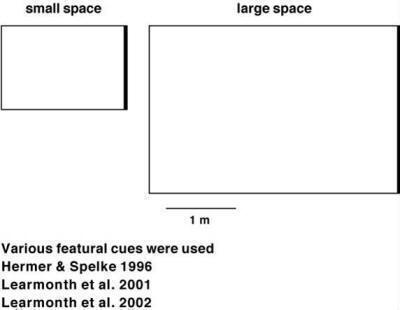 |
| Figure F-7: Comparison of spaces used in human experiments |
Room size is crucial to whether or not young children use featural cues. Learmonth et al. (2001) used an 8 by 12 foot room, not a 4 by 6 foot room.
Learmonth, Nadel & Newcombe (2002, Experiment 1), using a room with moveable walls, found that 4-year-olds did not use the featural cue to reorient in a small room (C 35% vs R 41%) but did use it in a larger room (C 57% vs R 23%).
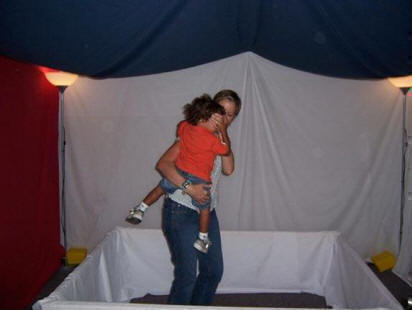 |
| Figure F-8: Child Being Disoriented in Small Enclosure Situated Within Larger Enclosure |
•Small waist-high enclosure (Hermer-Spelke size) centered within “large” room (Learmonth et al. size)
•Gives sense of difference in action possibilities between the two rooms—larger one is 4x the size of the smaller
Putting together the existing data, Cheng and Newcombe found the developmental pattern shown in Figures F-9 and F-10:
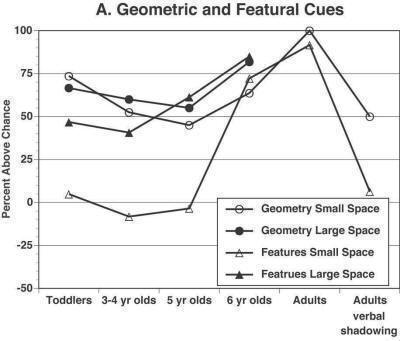 |
| Figure F-9: |
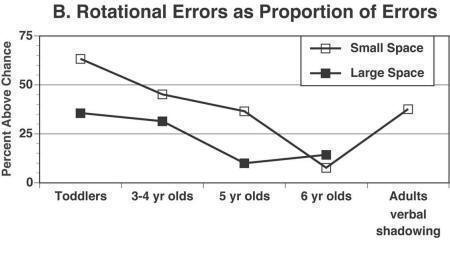 |
| Figure F-10: |
Looking at this developmental pattern undermines the language hypothesis, which cannot explain:
-
Why toddlers succeed in the larger room
-
•Why there is improvement in rooms of both size before and after hypothesized critical language acquisition
-
•Why room size makes a difference
However, the fact that adults doing verbal shadowing tasks do NOT use featural cues (Figure F-11) remains to be explained.
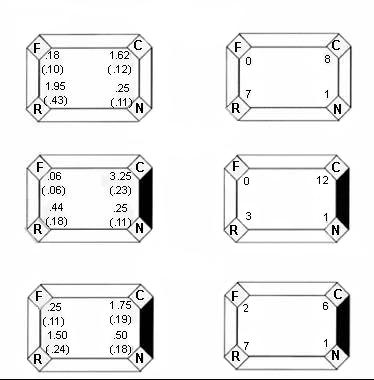 |
| Figure F-11: |
One new way to think about the roles of geometric and featural information is that the usage of each kind of information may vary with the situation and with the learning history of the organism (or other variables that determine individual differences). Consider a recent experiment by Hartley, Trinkler and Burgess (2004). Using virtual reality, people were placed in arenas in which they searched for targets. There were landmarks such as cliffs located in the far distance. Figure F-12 below gives a sense of the situation.
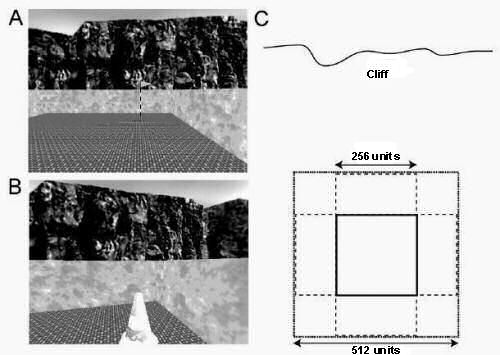 |
| Figure F-12: Stimuli (Panels A and B) and Layout (Panel C) used in experiments of Hartley, Trinkler, and Burgess (2004) |
On some trials, the shape of the arena was changed as shown in Figure F-13. People’s searches, as also shown in the figure, were guided by a variety of kinds of spatial information, including fixed distance to walls, a ratio of distances, and angles to corners of the arenas. The relative reliance on these types of information varied, with absolute distances more heavily weighted when distances were shorter, and thus likely to be estimated with less uncertainty. In addition, when the shape of the arena was altered, some people seemed to try to continue to use geometry to find the target while others seemed to rely on external features (such as the cliffs) for orientation. How different kinds of information are utilized and combined will likely be understood better in the near future as we analyse these kinds of situational and individual information more closely.
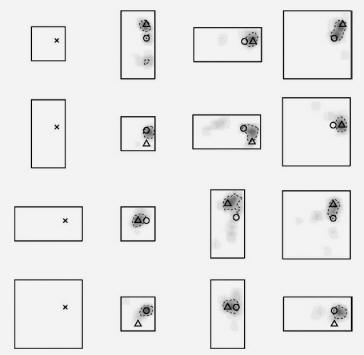 |
| Figure F-13: Results from test trials in experiments of Hartley, Trinkler, and Burgess (2004). |
|